Encountering a Woman’s Land Archive through personal narratives of loss using a materialist feminist disability framework and ecopoetic approach.
During an exhibition of the WomanShare Collective archive at the Wexner Center for the Arts I engage a materialist feminist understanding of disability. Misfitting is introduced by feminist disability scholar Rosemarie Garland-Thomson (2011) as “an effort to further think through the lived identity and experience of disability as it is situated in place and time” (p. 591).
Through the activity of rubbing/remembrance students think through the lived experiences of the WomanShare Collective, rubbing against the surfaces of their environment in response to archived photographs. Students encounter the archive through rhythmic rubbing processes relational with peers, sensations and emotions. To remember in eco-poetic relations with non-human others, we approach an ecology of relations “beyond the page,” and “move to notice and imagine” (Kuppers, p. 11, 131, 2022). Our more-than-writing activity reveals collective poetic textures in solidarity with interdependent and vulnerable bodies.

ARTEDU 2600 learners encountering the WomanShare archive at the Wex. Image by Lori Esposito.

The exterior of the archive exhibit. Image sourced from the Wexner Center of the Arts website.
My activity, rubbing/remembrance, engages with a Wexner Center for the Arts exhibition of the WomanShare Collective archives to generate inclusive pedagogy for neurodiverse learners in solidarity with a feminist land-based movement. This activity was introduced during my GTA appointment in ARTEDU 2600 (15152) Visual Culture: Investigating Diversity & Social Justice, during spring semester of 2022.
Sharing Circles: Carol Newhouse and the WomanShare Collective, presents the selections of work by lesbian photographer Newhouse (Sep 16, 2022–Dec 30, 2022). Upon entering the exhibition, I notice a photographic archive displayed on the interior walls of a wooden enclosure. I wander through the imagery, mostly black and white photography which pulls me to previous, intimate correspondences with my sister, Renee, while she lived on Women’s Land, Oregon (2009-2010). It seems serendipitous to encounter this exhibition, and stories surface from my memory bank. Treasures such as pinecones, and orange bark that she mailed me from Women’s Land offers connection, and clues about her life before she passed.
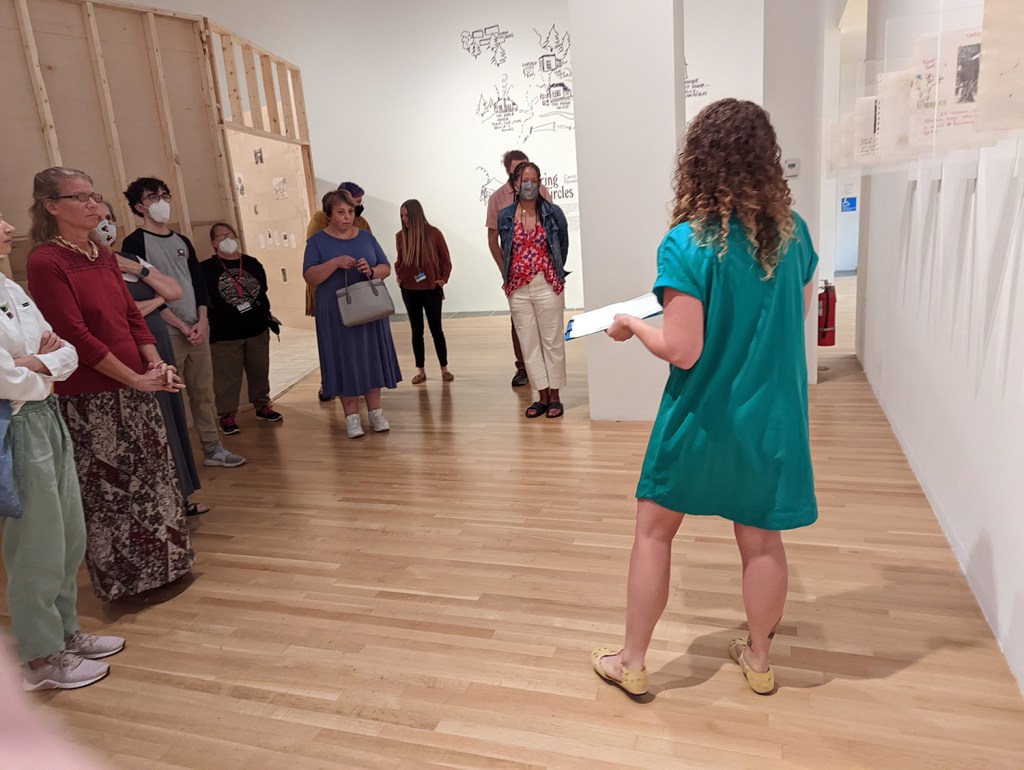
The Audio Cafe for the exhibition at the Wex. partners include Art Possible, Ohio, and local writing artist and sensory guide Elizabeth Sammons. Image by Lori Esposito
Arriving at the exhibition’s Audio Café I participate in an audio described sensory tour of the archive. The Wex’s accessibility manager, Helyn Marshall, organized the event and was my mentor during a semester-long Digital Access Design Internship (2021/2022). Together, we take a deeper dive into the intimacy and shared vulnerability of the WomanShare Collective. Established in the 1970s, female identifying folks created land trusts so they could take respite outside of mainstream patriarchal culture. Corinnne, T.A. (2004) writes that their lives were ridden with violence against women, gay people, and the environment.
Helyn points out “…Sometimes, repetitive physical motion gives a sense of comfort. It’s like you can change your mood a little bit, because you’re out of your brain.” (Starker. M., 2023)
During the Audio Cafe, Helyn passes around a transparent rectangular object. When it gets passed to me my fingers explore it’s surface.revealing two figures standing beside a vehicle. The tactile (Varcho, B. 2023) is based on one of Newhouse’s photographs offering access through touch to all and low vision visitors. For me, each bump and ridge stir memories of crackling dried leaves and caressing warm breezes. This multi-sensory access to the archive rejuvenates memories of correspondence with my sister.

Touching Helyn Marshall’s tactile during the audio cafe. Image by Lori Esposito.
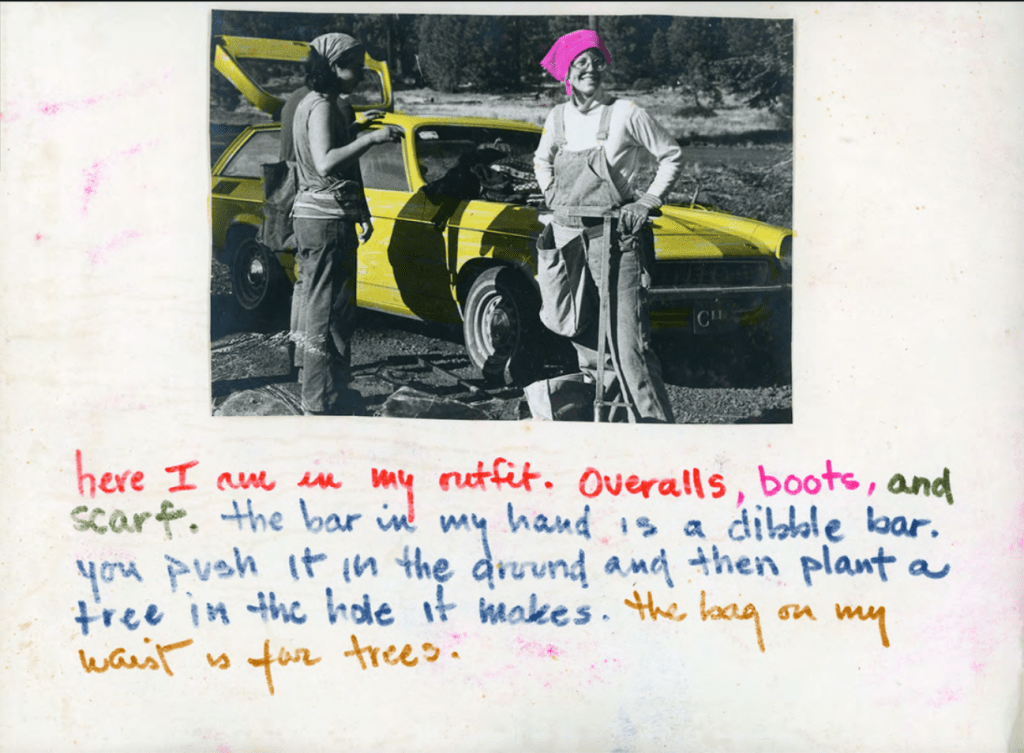
Carol Newhouse, page from a scrapbook for Carol’s grandmother, 1974. Image courtesy of the Wex.
Rubbing/remembrance with the WomanShare Collective Archive: An Embodied Writing Activity.
Exhibition: Sharing Circles: Carol Newhouse and the WomanShare Collective.
Activity Location: The Wexner Center for the Arts.
Duration: One hour
Arts-based activity (30 minutes)
Form small groups (2-3 people) to explore the textures of one photograph in the WomanShare archive (10 minutes), your choice. After your group has spent some time exploring the archive take tracing paper and a graphite stick on a sensory walk and create rubbings from encounters with the textures in your surroundings. Rubbings can trace bumpy or smooth surfaces from your belongings, organic matter and architecture. Place the tracing paper on the surface/texture you wish to record, and gently rub against it with the graphite (20 minutes). Try to create a collection of rubbings that inform a larger discussion about your photograph.
Narrative Inquiry (30 minutes)
Return to the gallery, and the photograph your group choose to reflect on. Take a moment to share your sensory walk experiences with your group, and the rubbings (5 minutes). Create a short story or description of your photographic evidence in relation with your rubbing experience (10 minutes). What did you think about? How did the process make you feel? Choose from one of the body-brain ticklers for a prompt.. Return to the gallery to share your group experience with the class (15 minutes).
Bodybrain Ticklers:
- Identify movement in the archive, and how it sparks your insight on how the WomanShare Collective lived.
- What senses come alive by your rubbing and sensory walk? What do you hear, smell, and feel?
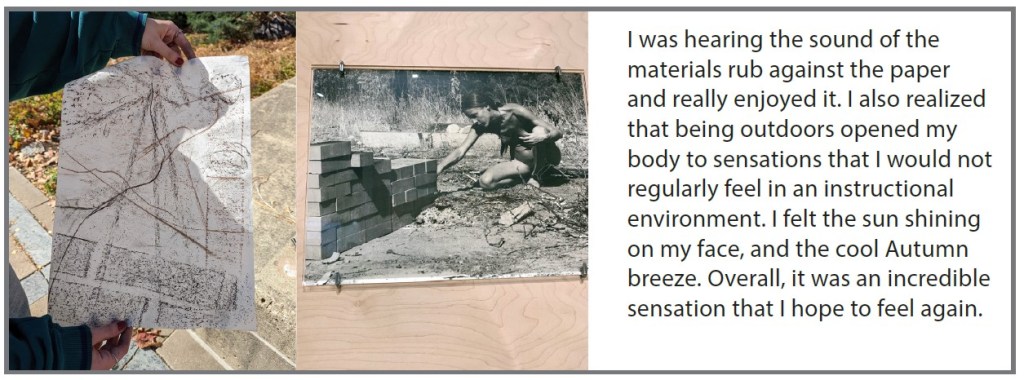
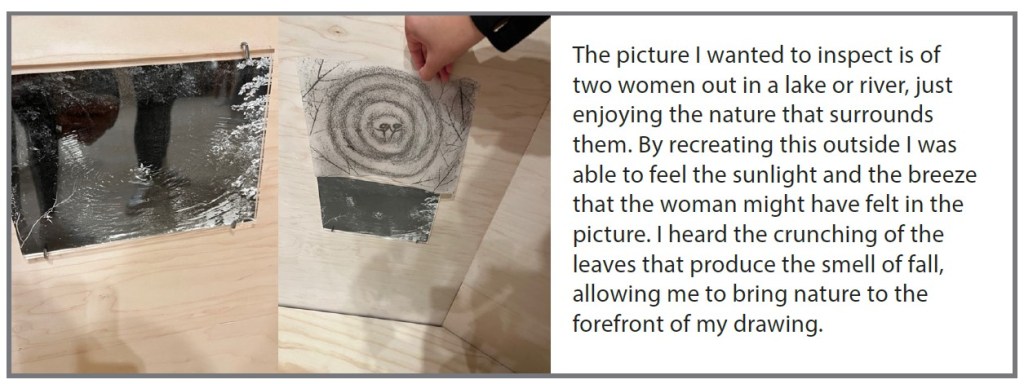


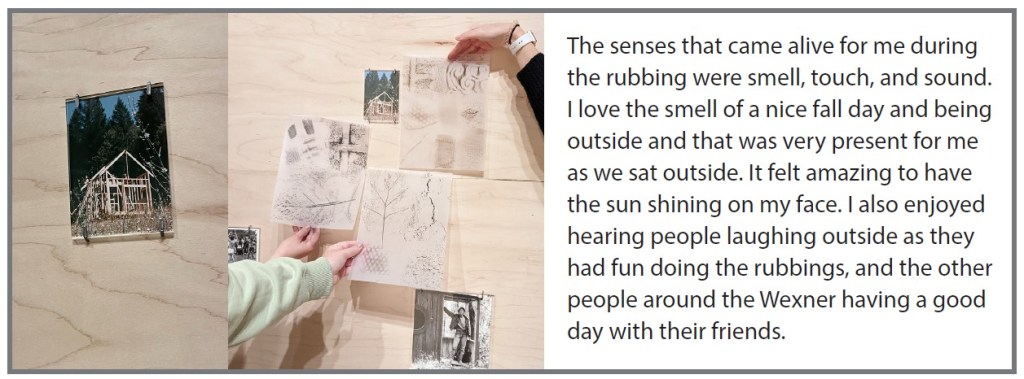

Selections of student works. The rubbings they made and the photographs they explored.

Rubbing/remembrance
by Lori Esposito
An audio clip of my rubbing poem.
My sister gifted me an archive of letters and objects from Women’s Land that tell stories about her lived experiences. I remember her as an activist and environmentalist, a generous friend and caring sibling. My cig gender privilege created a noticeable difference of access to education, healthcare and other community resources. These differences separated us in many ways, but for this project, I focus on our connections and reach across borders and categorizing systems. Through this touch and material engaged writing practice affirmative narratives emerge that are more complex, joyous, challenging, mundane. On Women’s Land, my sister got a fresh start to begin healing, lived, played and worked on a land co-owned and run with equal access to agriculture, shelter, and festivities. Herstory merged with this LGBTQ+ movement, while collectively caring through stewardship and social activism. Moved by our correspondence during her residence on Women’s Land, I created this rubbing/remembrance writing activity rooted in solidarity, moving across time, geographies, histories, and identities.
This practice draws from a feminist materialist disability concept of misfitting which Garland-Thompson (2011) describes as a lived identity situated in place. My sister and her chosen kin found respite with a land-based community on Women’s Land, where their political and spiritual ideals as lesbians, feminists, and environmentally minded folk could be put into practice (Corinne, T.A. 2004). Rubbing/remembrance experiences shared between my sister and myself during 2009-2010, attend to a dynamic memory of living on Women’s Land. At the intersections of gender and disability, this arts-based research informed activity does not disclose exploitative details, however, it accounts for a “dynamic encounter between flesh and world” (Garland- Thompson, 2011). Rubbings engage a repetitive, interdependent and materialist practices of becoming can be valued.
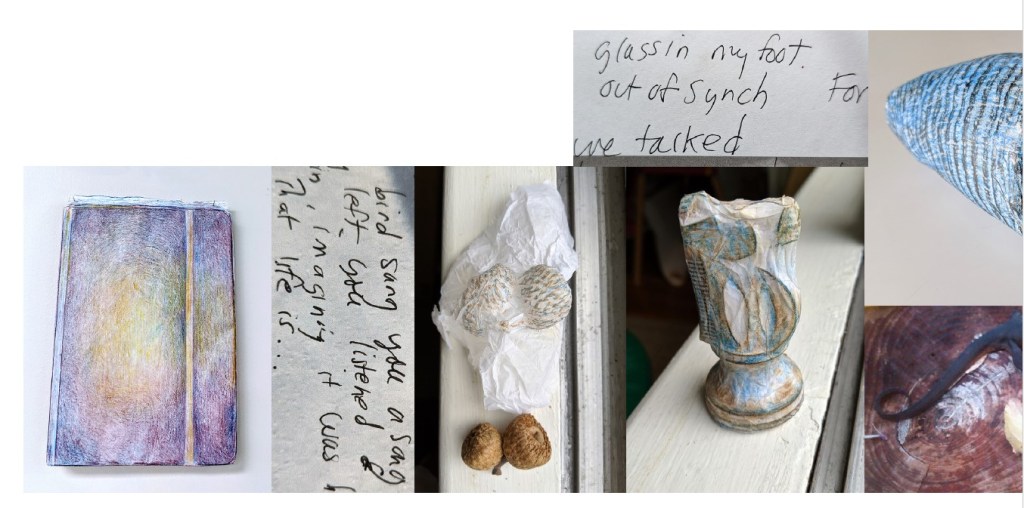
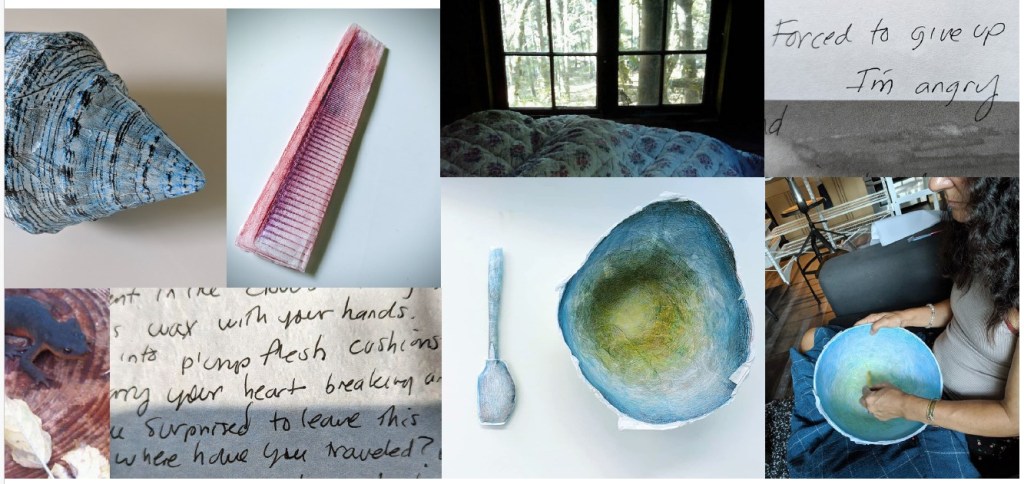
A digital collage of exchanged photographs, letters, and shaped rubbings made from objects and photographs shared between my sister and I while she lived on Women’s Land.
This memoryscape is dedicated to my mentor Helyn Marshall, the former Accessibility Manager at the Wexner Center for the Arts, and my sister Renee Esposito.
References:
Corinne, T.A. 2004. Oregon Women’s Land Trusy and Owl Farm. https://static1.squarespace.com/static/568c4ff1bfe8739973073ea5/t/56e32a24e321404618e9c6e4/1457728046666/HERSTORY.pdf
Garland-Thomson, R. (2011). Misfits: A feminist materialist disability concept. Hypatia, 26(3), 591-609.
Kafer, A. (2013). Feminist, queer, crip. Indiana University Press.
Kuppers, P. (2022). Eco Soma: Pain and joy in speculative performance encounters. U of Minnesota Press.
Starker. M. 2023. Access: New Tools to Welcome a Broader Audience. https://wexarts.org/read-watch-listen/access-new-tools-welcome-broader-audience
Varcho, B. 2023. Tactile Images Provide Low Vision Visitors Access to “Meditation Ocean” Exhibit at the Wex https://it.osu.edu/news/2023/02/16/tactile-images-provide-low-vision-visitors-access-meditation-ocean-exhibit-wex

Materials gathered in translucent baggies and mailed by my sister from Women’s Land.

A series of rubbing/remembrances created by my ARTEDU 2600 students.

Renee kneeling by a garden bed on Women’s Land (2009). Posted on Facebook during her residency.